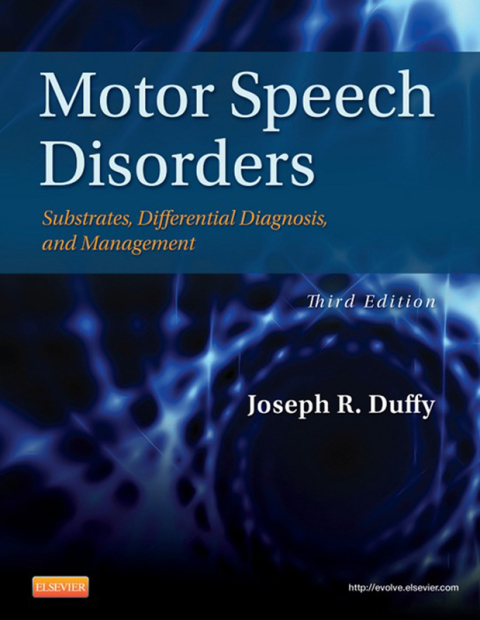Description
Efnisyfirlit
- Cover image
- Title page
- Table of Contents
- Copyright
- Dedication
- Preface
- Acknowledgments
- Part One: Substrates
- Chapter 1: Defining, Understanding, and Categorizing Motor Speech Disorders
- The Neurology of Speech
- The Neurologic Breakdown of Speech
- Some Basic Definitions
- Speech Disturbances that are Distinguishable from Motor Speech Disorders
- Prevalence and Distribution of Motor Speech Disorders
- Methods for Studying Motor Speech Disorders
- Categorizing Motor Speech Disorders
- Summary
- Chapter 2: Neurologic Bases of Motor Speech and Its Pathologies
- Gross Neuroanatomy and Major Neurologic Systems∗
- Primary Structural Elements of the Nervous System
- Clinicopathologic Correlations
- The Speech Motor System
- The Conceptual-Programming Level and Speech
- Summary
- Chapter 3: Examination of Motor Speech Disorders
- Purposes of Motor Speech Examination
- Guidelines for Examination
- The Motor Speech Examination
- Summary
- Appendix A Deviant Speech Characteristics Encountered in Motor Speech Disorders
- Appendix B Grandfather Passage13
- Part Two: The Disorders and Their Diagnoses
- Chapter 4: Flaccid Dysarthrias
- Clinical Characteristics of Flaccid Paralysis
- Etiologies
- Speech Pathology
- Cases
- Summary
- Chapter 5: Spastic Dysarthria
- Anatomy and Basic Functions of the Direct and Indirect Activation Pathways
- Clinical Characteristics of Upper Motor Neuron Lesions and Spastic Paralysis
- The Relationship of Spastic Paralysis to Spastic Dysarthria
- Etiologies
- Speech Pathology
- Cases
- Summary
- Chapter 6: Ataxic Dysarthria
- Anatomy and Basic Functions of the Cerebellar Control Circuit
- Localization of Speech within the Cerebellum
- Clinical Characteristics of Cerebellar Lesions and Ataxia
- Etiologies
- Speech Pathology
- Cases
- Summary
- Chapter 7: Hypokinetic Dysarthria
- Anatomy and Basic Functions of the Basal Ganglia Control Circuit
- Clinical Characteristics Of Basal Ganglia Control Circuit Disorders Associated With Hypokinetic Dysarthria
- Etiologies
- Speech Pathology
- Cases
- Summary
- Chapter 8: Hyperkinetic Dysarthrias
- Anatomy and Basic Functions of the Basal Ganglia Control Circuit
- Clinical Characteristics of Basal Ganglia Control Circuit Disorders Associated with Hyperkinetic Dysarthrias
- Etiologies
- Speech Pathology
- Cases
- Summary
- Chapter 9: Unilateral Upper Motor Neuron Dysarthria
- Anatomy and Basic Functions of the Upper Motor Neuron System
- Clinical Characteristics Associated with Unilateral Upper Motor Neuron Lesions
- Etiologies
- Speech Pathology
- The Distinctiveness of Unilateral Upper Motor Neuron Dysarthria: Conclusions and Clinical Suggestions
- Cases
- Summary
- Chapter 10: Mixed Dysarthrias
- Etiologies
- Speech Pathology
- Cases
- Summary
- Chapter 11: Apraxia of Speech
- Anatomy and Basic Functions of the Motor Speech Programmer
- Nonspeech, Nonoromotor, and Nonlinguistic Characteristics of Patients with Apraxia of Speech
- Etiologies
- Speech Pathology
- CASES
- Summary
- Chapter 12: Neurogenic Mutism
- Motor Speech Disorders and Mutism
- Aphasia and Mutism
- Disorders of Arousal, Responsiveness, and Diffuse Cortical Functions
- Etiology-Specific Neurogenic Mutism
- Cases
- Summary
- Chapter 13: Other Neurogenic Speech Disturbances
- Other Speech Disturbances Associated with Unilateral, Bilateral, Multifocal, or Diffuse Central Nervous System Abnormalities
- Other Speech Disturbances Associated with Left Hemisphere Lesions
- Other Speech Disturbances Associated with Right Hemisphere Lesions—Aprosodia
- Cases
- Summary
- Chapter 14: Acquired Psychogenic and Related Nonorganic Speech Disorders
- Etiologies
- Speech Pathology
- Cases
- Summary
- Chapter 15: Differential Diagnosis
- General Guidelines for Differential Diagnosis
- Distinguishing Among the Dysarthrias
- Distinguishing Dysarthrias from Apraxia of Speech
- Distinguishing Motor Speech Disorders from Aphasia
- Distinguishing Among forms of Neurogenic Mutism
- Distinguishing Motor Speech Disorders from other Neurogenic Speech Disorders
- Distinguishing Neurogenic from Psychogenic Speech Disorders
- Summary
- Part Three: Management
- Chapter 16: Managing Motor Speech Disorders: General Considerations
- Management Issues and Decisions
- Approaches To Management
- Foundations for Behavioral Management
- Treatment Efficacy
- Summary
- APPENDIXA Information Resources
- APPENDIXB Practice Guidelines, Systematic Reviews, and Evidence-Based Practice Publications and Related Sources of Information Regarding Systematic Reviews and Evidence-Based Practice Guidelines for Speech-Language Pathology, with Emphasis on MSDs
- Chapter 17: Managing the Dysarthrias
- Speaker-Oriented Treatment
- Speaker-Oriented Treatment for Specific Dysarthria Types
- Communication-Oriented Treatment
- Summary
- Chapter 18: Managing Apraxia of Speech
- General Perspectives
- Approaches to Management
- Principles and Guidelines for Behavioral Management
- Behavioral Management Approaches
- Summary
- Chapter 19: Management of Other Neurogenic Speech Disturbances
- Neurogenic Stuttering
- Palilalia
- Echolalia
- Cognitive and Affective Disturbances
- Aphasia
- Pseudoforeign Accent
- Aprosodia
- Summary
- Chapter 20: Managing Acquired Psychogenic and Related Nonorganic Speech Disorders
- General Principles and Guidelines
- General Treatment Techniques
- Symptomatic Treatment for Specific PNSDs
- Summary
- Index






